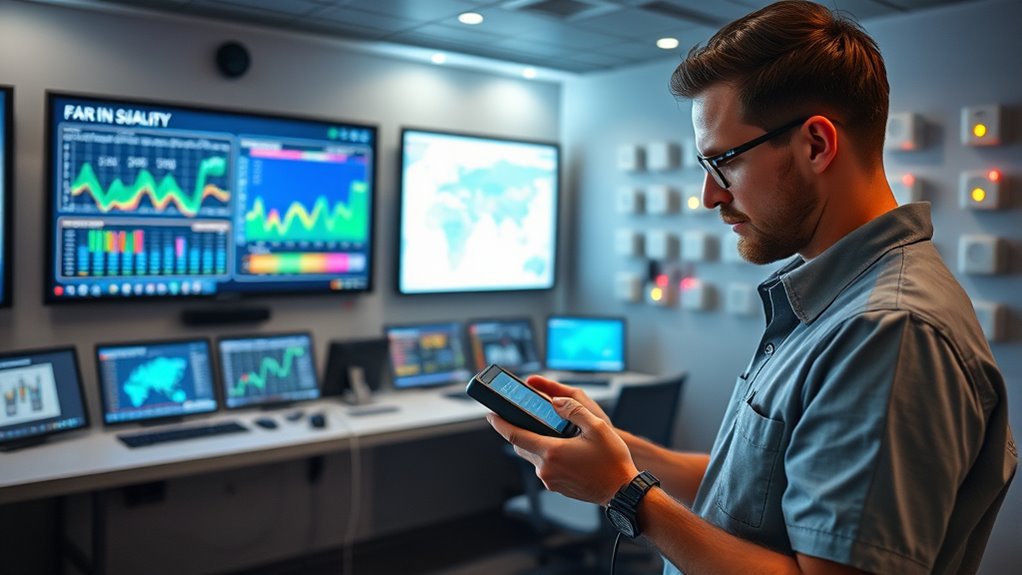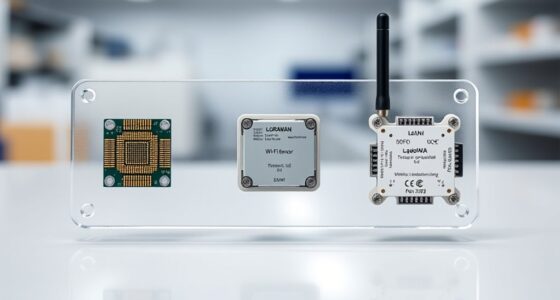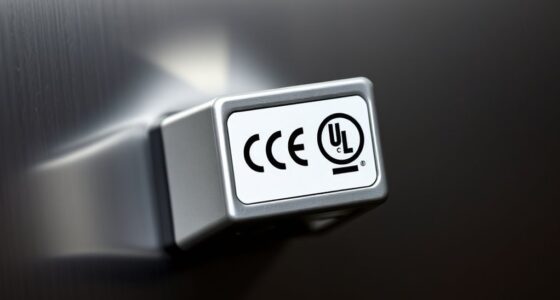Remote diagnostics for air quality monitoring systems let you easily monitor, verify, and calibrate sensors from afar, saving time and reducing the need for on-site visits. You can quickly identify sensor issues, perform calibrations, and troubleshoot problems in real-time, ensuring your data stays accurate and reliable. Plus, you’ll enhance system security and maintenance efficiency. Keep exploring to discover how remote diagnostics can optimize your air quality monitoring network and ensure consistent, quality data.
Key Takeaways
- Enables remote monitoring of sensor performance, ensuring timely detection of calibration drift and system anomalies.
- Facilitates remote calibration checks and adjustments, maintaining data accuracy without on-site visits.
- Enhances data security through encrypted communication channels during remote diagnostics operations.
- Reduces maintenance costs and downtime by allowing troubleshooting and firmware updates remotely.
- Supports long-term data reliability and system health monitoring for large, dispersed air quality networks.

Remote diagnostics have become essential for maintaining air quality monitoring systems, especially as these networks expand across diverse locations. When you’re overseeing these systems, you realize that consistent sensor calibration is *imperative* to *guarantee* accurate readings. Calibration involves adjusting sensors to match known standards, which is *crucial* because even minor deviations can lead to false data, affecting air quality assessments. Traditional calibration methods often require manual intervention, which isn’t feasible for widespread networks. Remote diagnostics allow you to perform calibration checks and adjustments from afar, saving time and resources. This capability *assures* sensors remain precise over time, reducing the risk of inaccurate data skewing your analysis or decision-making processes. Additionally, understanding the importance of sensor calibration underscores the need for essential maintenance to keep the system functioning correctly.
Data security is another *essential* aspect when managing remote diagnostics. As you access sensors and system data remotely, you must safeguard sensitive information against cyber threats. Implementing robust encryption protocols and secure communication channels helps protect data integrity and confidentiality. You don’t want malicious actors intercepting or altering data, as this could compromise the entire monitoring system’s credibility. *Making certain* data security also involves regular software updates and authentication measures, preventing unauthorized access. When you prioritize data security, you maintain trust in your network’s reliability and *affirm* compliance with regulatory standards.
Remote diagnostics provide you with real-time insights into system performance, enabling proactive maintenance. Instead of waiting for sensors to malfunction or produce suspect data, you receive alerts about anomalies or calibration drifts immediately. This proactive approach allows you to schedule calibration and repairs before issues escalate, minimizing downtime and data gaps. You can remotely troubleshoot system errors, identify faulty components, and even update firmware without physically visiting each site. This agility is especially valuable for monitoring air quality across multiple, hard-to-reach locations, where on-site maintenance would be costly and time-consuming.
Furthermore, remote diagnostics enhance your ability to maintain consistent data quality. By continuously monitoring sensor health and calibration status, you can *assure* that your air quality data remains reliable over time. This consistency is *pivotal* for long-term studies, policymaking, and public health advisories. With secure remote access, you can also collaborate with experts or vendor support teams efficiently, sharing diagnostics data and implementing solutions swiftly. Ultimately, integrating remote diagnostics into your air quality monitoring network helps you optimize performance, *uphold* data security, and deliver accurate, trustworthy results to stakeholders.
Frequently Asked Questions
How Secure Is the Remote Diagnostic Data Transmission?
Remote diagnostic data transmission is generally secure if you use strong data encryption and follow cybersecurity best practices. While cybersecurity risks exist, encryption helps safeguard your data from interception or tampering during transfer. To guarantee safety, keep your systems updated, use secure networks, and implement multi-layer security measures. By doing so, you minimize risks and maintain the confidentiality and integrity of your air quality monitoring system’s diagnostic data.
Can Remote Diagnostics Predict System Failures Before They Happen?
Think of remote diagnostics as your system’s crystal ball. They enable predictive maintenance by analyzing data trends to foresee potential issues. You can catch failure prediction early, much like spotting dark clouds before a storm. This proactive approach helps you prevent costly breakdowns, keeping your air quality monitoring system running smoothly. With failure prediction, you stay one step ahead, ensuring consistent, reliable performance without surprises.
What Are the Costs Associated With Implementing Remote Diagnostics?
You’ll find that the costs associated with implementing remote diagnostics mainly involve initial implementation expenses and ongoing maintenance. Conducting a thorough cost analysis helps you understand hardware upgrades, software integration, and training costs. While the upfront expenses may seem significant, the long-term benefits—like reduced downtime and faster troubleshooting—can offset these costs. Overall, careful planning guarantees your investment delivers value through improved system reliability and operational efficiency.
How Do Remote Diagnostics Integrate With Existing Air Quality Systems?
You integrate remote diagnostics with your existing air quality systems by connecting sensors to a central platform that uses data analytics to monitor performance. This setup allows you to perform sensor calibration remotely, ensuring accuracy without onsite visits. Data analytics helps identify issues early, so you can address potential problems quickly. The integration streamlines maintenance, improves data reliability, and keeps your air quality monitoring system running efficiently.
Are There Any Limitations to Remote Diagnostics in Harsh Environments?
In harsh environments, remote diagnostics face limitations like sensor calibration issues caused by extreme temperatures or dust, which can affect data accuracy. Power supply challenges also arise, especially if batteries drain quickly or solar power becomes unreliable. You might need to perform manual calibrations or supply backup power sources regularly. Despite these obstacles, remote diagnostics still offer valuable insights, but you must guarantee robust systems to handle environmental stresses effectively.
Conclusion
In brief, remote diagnostics transform air quality monitoring systems into vigilant guardians, constantly watching over environmental health. Like a skilled doctor diagnosing a patient from afar, these systems promptly identify issues, ensuring quick fixes and continuous operation. By embracing remote diagnostics, you enhance reliability and reduce downtime, making your monitoring network as resilient as a fortress. Ultimately, this technology empowers you to safeguard the environment more effectively, just as a lighthouse guides ships safely through foggy seas.










